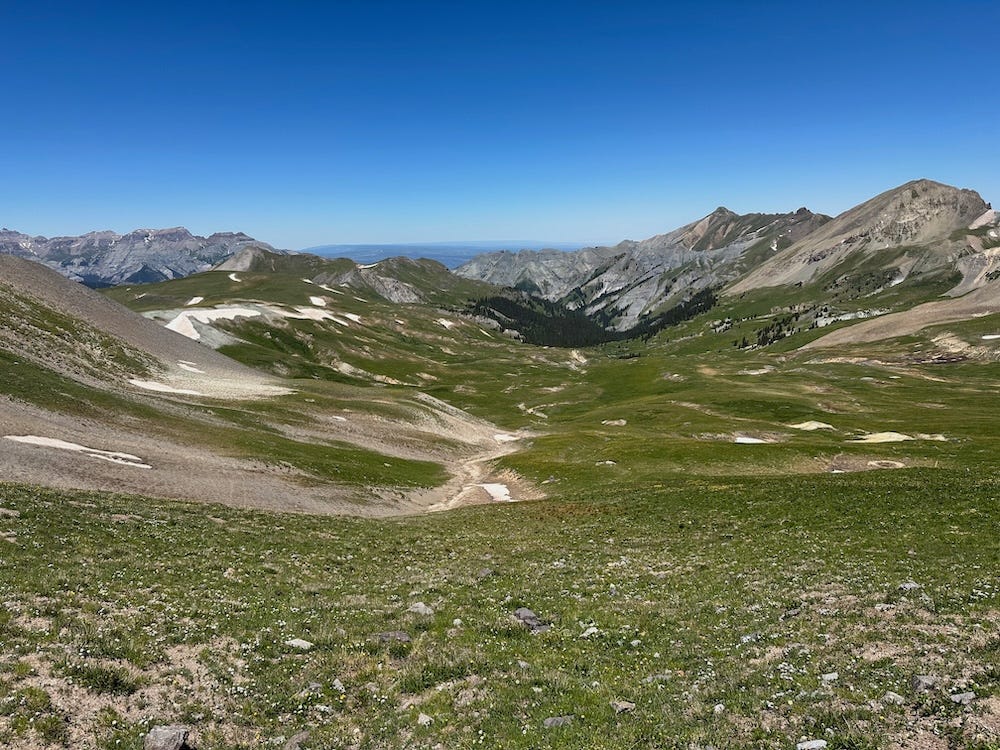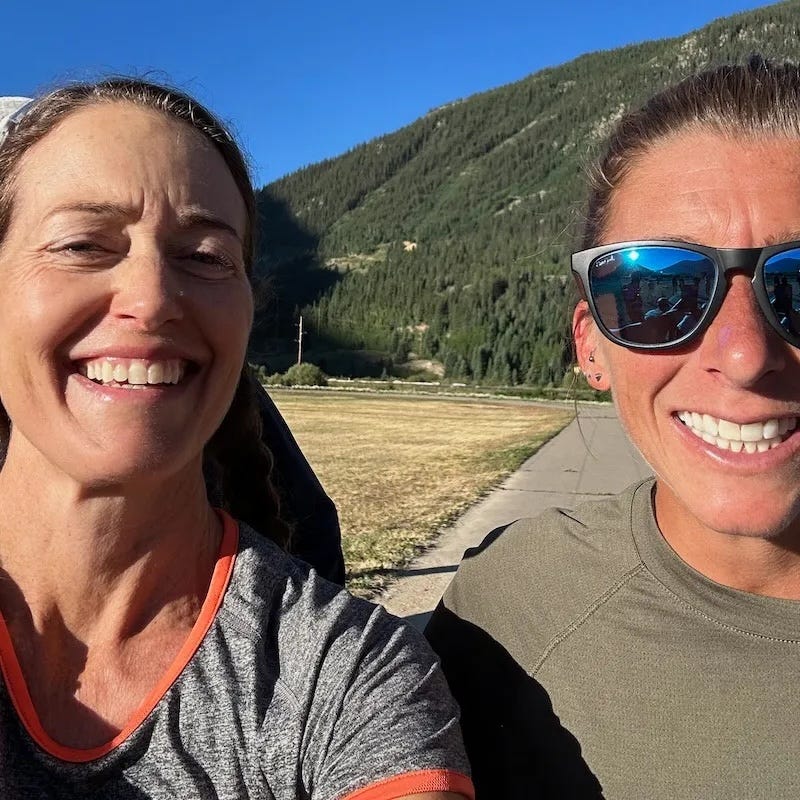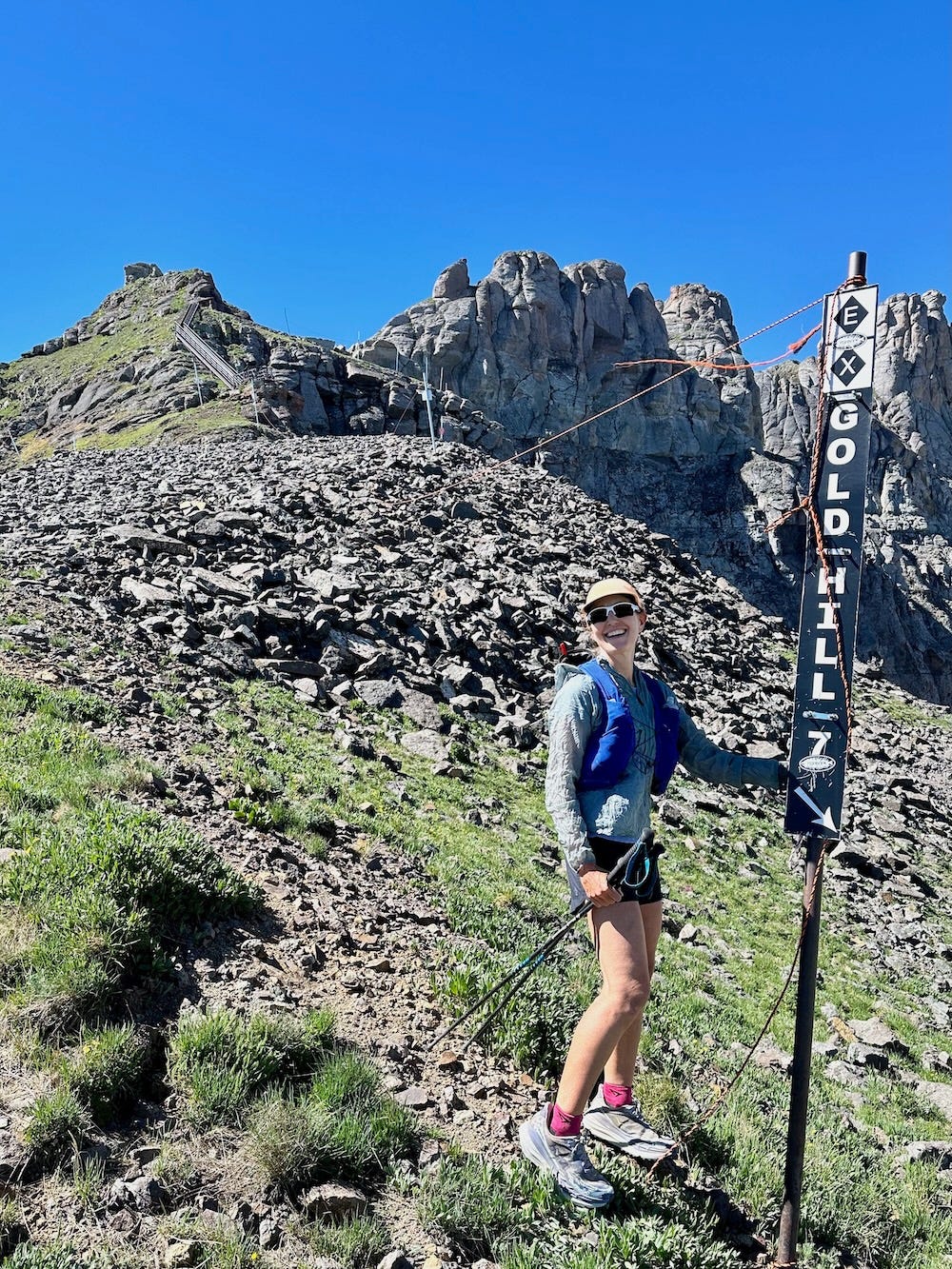Welcome back. This week’s post differs from my usual narratives. After a brief update with links about this weekend’s Hardrock Hundred—Colorado’s epic ultra and one of my big life goals—I write about something I’ve never written about here before, music! I am not a music reviewer or an expert in any way, but this concerns life in general as much as the music. Thanks for being here.
It’s Christmas in July in Silverton
It’s Hardrock week! Even those of us on the sidelines because we can’t get a spot to run it feel the buzz and make the pilgrimage to Silverton to spectate and participate as crew and volunteers.
If you’ve followed this newsletter for the past three years, you know I’ve written a great deal about the magic of the Hardrock Hundred Endurance Run and how I’m on a decade-long quest to get a spot to run it, having run multiple 100-mile qualifiers and put my name in the lottery since 2015. Fingers crossed that one of my 256 tickets will get pulled this December so I can finally attempt it in 2025.
I’m heading to Silverton today and giving a presentation at the request of Hardrock’s race director about regional history. I’ve prepared a slide show about historical stories that happened at key points along the 100-mile route. I hope it inspires runners as they make their way in this year’s clockwise direction from Silverton to Telluride to Ouray and over the 14er Handies. If you happen to be reading this in Silverton today (Wednesday, July 10), please come to my talk at the school at 4:30.
Then I’ll focus on crewing and pacing my friend Yitka Winn late Friday from the Ouray to Animas Forks section. I’ll return to Silverton for some rest and then volunteer at the Silverton finish line aid station from 10 p.m. Saturday through 6 a.m. Sunday. I can’t think of a better way or place to pull an all-nighter (unless I were running the final segments of the race). I plan to share some finish-line stories in next week’s post. Interesting things and colorful characters always emerge in those nighttime hours at the event’s finish line, as runners trickle in depleted but overjoyed to have made it before the 48-hour cutoff.

To learn more about Hardrock, I invite you to read some past posts about it for context. For info on this year’s event, read iRunFar’s overview article and follow their live coverage, along with the livestream of the event.
Hardrock’s Draw: Why Hardrock matters to me and so many, and how the lottery works and frustrates.
Anatomy of an Aid Station: How a Hardrock aid station functions, and what we can learn about it for our own ultra prep.
How a Working Mom Trains for the Hardrock Hundred: I spotlight Yitka Winn, an accomplished ultrarunner who trained for Hardrock on relatively low mileage while working full time and raising a toddler. This is an inspiring story for anyone who thinks “I’m too busy to do anything like that”!
Hardrock’s Epilogue: A scene piece from last year’s post-Hardrock “depletion mile,” plus what makes Hardrock “Hardwalk.”

I can’t stop thinking about and listening to Jon Bon Jovi
I want to share something that seemingly has nothing to do with this newsletter’s main topic of mountain running. Yet it has to do with aging, performance, creativity, health, and following your passion—all things I touch on frequently and to which readers here can relate.
These past few weeks, to my surprise, I became a major Bon Jovi fan. I am exploring the band’s discography and finding myself driving slowly to have more time to sit in the car listening and singing along with their songs. I’m reveling in the banger anthems from their 1986 breakthrough album, Slippery When Wet, which put me back in time to my freshman year in college, and then I’m finding myself emotionally transfixed and mesmerized by tracks on their brand-new album, Forever.
This all came about because of the four-part documentary series Thank You, Good Night on Hulu about the band’s 40 years. I also listened to Terry Gross’s excellent interview with Jon Bon Jovi on NPR’s “Fresh Air.”
It took me a couple of weeks to work through the four-part series, because the middle sections are long and perhaps overly detailed about the band’s management. But I want to watch the final part at least one more time because it felt so epic and poignant. It culminates in Jon Bon Jovi’s comeback from surgery to repair his vocal chords and his determination to find his voice again. His commitment, energy, thoughtfulness, creativity, and mostly his courage to try again—knowing he’ll never regain the range to hit the high notes in “Livin’ on a Prayer,” but making the most of the vocal range he still has—touched me deeply.
Something kind of similar happened last year when I watched The Eras Tour movie and then spent weeks discovering all the Taylor Swift songs I missed when they first were released. But Jon Bon Jovi, the person and artist, affects me in ways Taylor Swift never will because he’s my generation, or just a bit older. He’s 62, with a deep soul and elder wisdom but also an endearing cheekiness. He seems like Bruce Springsteen’s little brother. The two have a friendship dynamic that makes it seem like they could in fact be brothers.
Why did his evolution and comeback story move me so much? It’s because of where I’ve been and where I’m at in life. I happen to be writing and thus thinking a great deal about my adolescence and young adulthood for my memoir, so in my mind I’m spending a lot of time in the 1980s and ’90s.
This documentary’s voluminous footage from that era—like all the clips from Kurt Loder on MTV News reporting on Bon Jovi, and all the big-hair styles—made me want to rewind to that time, to the age my kids are now, and be in a stadium for a big-name show or even backstage (as I was able to do occasionally, thanks to a good friend’s connections in the music industry; I stood 20 feet from Slash performing onstage in the Oakland Coliseum one memorable night).
I miss that person who danced and partied and felt everything deeply, and watching this documentary, I reconnected with that dormant part of me.
More than that, the documentary hit me at a sensitive time when I’m confronting my aging and breakdown; more specifically, my knee pain (IT Band flareup plus cartilage degeneration) and lower back stiffness (arthritis?) that are slowing me down further.
It’s hard to feel inadequate doing something that used to make you feel skilled and confident.
It’s hard to feel pain doing something that used to bring you not just satisfaction, but a real physical and mental high.
Jon Bon Jovi experienced those feelings—that decline and frustration—and he came out the other side. Now he’s pouring his heart into songwriting and singing as he always has, and as best he can at this stage in life, rather than dwelling on his past glory.
I find myself listening to his new song “Legendary” (which with “Waves” are my two favorite songs on the new album) and looping his refrain in my head like a mantra, absorbing its twist on the message to be here now and be grateful:
Got what I want ‘cause I got what I need
Got a fistful of friends that’ll stand up for me
Right where I am is where I wanna be
Given how I’m liking the band’s music now, I’m wondering why I wasn’t into Bon Jovi after the ‘90s. I listened early on to their hits, along with Guns N Roses, but my ear was tuned more to alternative music than pure rock, and Pearl Jam and Nirvana diverted my attention. I thought Bon Jovi went away in the 2000s. But they have been here all along, maturing and growing yet staying true to their roots.
Jon and guitarist Richie Sambora parted ways 11 years ago, and that whole chapter in the documentary is handled well—the breakup of a bromance and dynamic duo that tugged at my heart—and then the new guy who was plucked from relative YouTube obscurity to fill the gaping hole left by Richie makes for a delightful, funny side story.
Last week, I listened to many of their old tracks for the first time. I discovered their 2007 album Lost Highway and added the title track, a perfect roadtrip song, to my Liked collection. I also listened, amazed, to his 2020 album, with the song “American Reckoning” about George Floyd’s murder, and thought, this is Bon Jovi? He sounded more like Bruce singing “Streets of Philadelphia” during the height of the AIDS crisis.
So this is my message to you, especially if you’re feeling over the hill and think your best days—your greatest hits, your best performances—are in the past: Watch the documentary. Listen to the NPR interview. Play the music. Keep your loved ones and true friends close.
Then create something new and go climb a mountain, even if it’s just a hill.
If you’d like to support this newsletter but would rather not subscribe at the supporter level, please consider a small donation to this virtual tip jar. Thank you!




I’m with you I was Nirvana all the way. Great post sometimes it’s hard to look back but those crazy free dancing wild children are still inside us waiting for us to lighten up enough to let them out to play …….. I know easier said than done, but I do believe it
The line "I miss that person who danced and partied and felt everything deeply" reminds me so much of Tenille Townes' song "Girl Who Didn't Care"! Different age range, but the nostalgia for your younger self is the same.